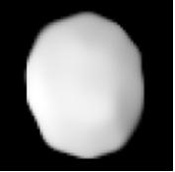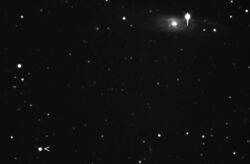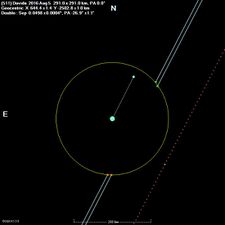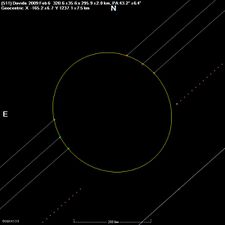Astronomy:511 Davida
 | |
| Discovery | |
|---|---|
| Discovered by | R. S. Dugan |
| Discovery date | May 30, 1903 |
| Designations | |
Designation | (511) Davida |
| Pronunciation | /dəˈviːdə/,[2] Latin Dāvīda |
| Named after | David Peck Todd |
| 1903 LU | |
| Minor planet category | main-belt · (outer) Meliboea [1] |
| Adjectives | Davidian /dəˈvɪdiən/[3] |
| Orbital characteristics[4] | |
| Epoch July 01, 2021 (JD 2459396.5, heliocentric) | |
| |{{{apsis}}}|helion}} | 3.759 AU |
| |{{{apsis}}}|helion}} | 2.569 AU |
| 3.163 AU | |
| Eccentricity | 0.188 |
| Orbital period | 5.626 yr (2055 d) |
| Mean anomaly | 113° |
| Inclination | 15.94° |
| Longitude of ascending node | 107.6° |
| 337.2° | |
| Physical characteristics | |
| Dimensions | c/a = 0.70±0.06[5] (357 ± 2)×(294 ± 2)×(231 ± 50) km[6][7] |
| Mean diameter | 298±4 km[5] |
| Mass | (26.6±7.3)×1018 kg[5] (38±2)×1018 kg[lower-alpha 1][7] |
| Mean density | 1.92±0.53 g/cm3[5] 2.97±1.30 g/cm3[7] |
| Rotation period | 0.2137 d (5.130 h) |
| Albedo | 0.076±0.007 geometric (0.717±0.013 BV, 0.363±0.020)[4] |
| Physics | ~160 K |
Spectral type | C |
| Apparent magnitude | 9.50[8] to 12.98 |
| Absolute magnitude (H) | 6.43[4] |
Davida (minor planet designation: 511 Davida) is a large C-type asteroid. It is one of the largest asteroids; approximately tied for 7th place, to within measurement uncertainties, and the 5th or 6th most massive. It was discovered by R. S. Dugan in 1903. Davida is named after David Peck Todd, an astronomy professor at Amherst College.
Physical characteristics

Davida is approximately 270–310 km in diameter and comprises an estimated 1.5% of the total mass of the asteroid belt.[9][10][11] It is a C-type asteroid, which means that it is dark in colouring with a carbonaceous chondrite composition.
From 2002 to 2007, astronomers at the Keck Observatory used the Keck II telescope, which is fitted with adaptive optics, to photograph Davida. The asteroid is not a dwarf planet: there are at least two promontories and at least one flat facet with 15-km deviations from a best-fit ellipsoid. The facet is presumably a 150-km global-scale crater like the ones seen on 253 Mathilde. Conrad et al. (2007) show that craters of this size "can be expected from the impactor size distribution, without likelihood of catastrophic disruption of Davida."
Mass
In 2001, Michalak estimated Davida to have a mass of (6.64±0.56)×1019 kg.[12][13] In 2007, Baer and Chesley estimated Davida to have a mass of (5.9±0.6)×1019 kg.[14] (As of 2010), Baer suggests Davida has a mass of (3.84±0.20)×1019 kg.[9] This most recent estimate by Baer indicates that Davida is approximately tied with 704 Interamnia as the fifth-most-massive asteroid, though the error bars of Interamnia are large.[9]
Occultations
There have been 9 occultation events observed since 1987, many of which produced two or three chords.[15] Two examples shown here.
Notes
- ↑ (18.96 ± 0.99) × 10−12 M☉
References
- ↑ "Asteroid 511 Davida – Nesvorny HCM Asteroid Families V3.0". Small Bodies Data Ferret. https://sbntools.psi.edu/ferret/SimpleSearch/results.action?targetName=511+Davida.
- ↑ John Daintith & William Gould, eds. (2006) The Facts On File Dictionary of Astronomy. 5th edition. Infobase Publishing.
- ↑ "Davidian". Merriam-Webster Dictionary. https://www.merriam-webster.com/dictionary/Davidian.
- ↑ 4.0 4.1 4.2 JPL data Retrieved 2021-09-29
- ↑ 5.0 5.1 5.2 5.3 P. Vernazza et al. (2021) VLT/SPHERE imaging survey of the largest main-belt asteroids: Final results and synthesis. Astronomy & Astrophysics 54, A56
- ↑ Conrad (2007). Measurements of the short axis are less precise than the other two, but also involve a discrepancy between fitting the convolved and deconvolved images (241±40 km), and fitting the edges (191±114 km).
- ↑ 7.0 7.1 7.2 James Baer, Steven Chesley & Robert Matson (2011) "Astrometric masses of 26 asteroids and observations on asteroid porosity." The Astronomical Journal, Volume 141, Number 5
- ↑ {{cite web |title=Bright Minor Planets 2003 |publisher=Minor Planet Center |url=http://www.cfa.harvard.edu/iau/Ephemerides/Bright/2003 |access-date=2008-05-21
- ↑ 9.0 9.1 9.2 Baer, James (2010). "Recent Asteroid Mass Determinations". Personal Website. http://home.earthlink.net/~jimbaer1/astmass.txt.
- ↑ Pitjeva, E. V. (2005). "High-Precision Ephemerides of Planets—EPM and Determination of Some Astronomical Constants" (PDF). Solar System Research 39 (3): 176. doi:10.1007/s11208-005-0033-2. Bibcode: 2005SoSyR..39..176P. http://iau-comm4.jpl.nasa.gov/EPM2004.pdf.
- ↑ "Baer Mass of 511 Davida" 0.220 / "Mass of Mbelt" 15 = 0.0146
- ↑ Michalak, G. (2001). "Determination of asteroid masses (6) Hebe, (10) Hygiea, (15) Eunomia, (52) Europa, (88) Thisbe, (444) Gyptis, (511) Davida and (704) Interamnia". Astronomy & Astrophysics 374: 703–711. doi:10.1051/0004-6361:20010731. Bibcode: 2001A&A...374..703M. http://www.aanda.org/index.php?option=article&access=standard&Itemid=129&url=/articles/aa/abs/2001/29/aa10228/aa10228.html. Retrieved 2008-11-04.
- ↑ (3.34±0.28)×10−11 solar masses, per Michalak (2001), extended dynamic model.
- ↑ Baer, James; Steven R. Chesley (2007). "Astrometric masses of 21 asteroids, and an integrated asteroid ephemeris". Celestial Mechanics and Dynamical Astronomy (Springer Science+Business Media B.V. 2007) 100 (2008): 27–42. doi:10.1007/s10569-007-9103-8. Bibcode: 2008CeMDA.100...27B. "(2.98±0.30)×10−11 solar masses".
- ↑ "PDS Asteroid/Dust Subnode" (in en). https://sbn.psi.edu/pds-staging/resource/occ.html.
External links
| Wikimedia Commons has media related to 511 Davida. |
- Asteroid occultations, IOTA – International Occultation Timing Association (2011)
- Time lapse photography of Davida
- Al Conrad's research page at Keck
- 511 Davida at AstDyS-2, Asteroids—Dynamic Site
- 511 Davida at the JPL Small-Body Database
 |






